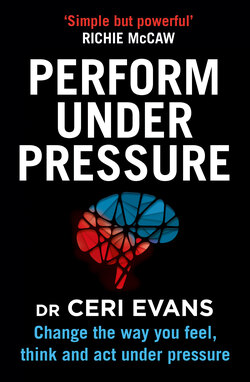Читать книгу Perform Under Pressure - Ceri Evans - Страница 15
Chapter 2, Two Minds – Introducing Red and Blue
ОглавлениеOur brain is the part of our body that has the greatest influence on our performance under pressure.
Even when a challenge is mainly physical – such as training for a marathon – pressure places demands on us mentally as we solve problems, make decisions, adjust timing, fight through the discomfort, and much more. Our mental response is what makes the difference.
Our brain is easily the most complex organ in our body – in fact, it’s the most complex thing in the universe. The numbers people use in talking about the brain are so big, and at the same time so small, that they’re hard to fathom.
The human brain contains roughly 100 billion neurons (nerve cells), which generate trillions of synapses (connections) with other neurons. At the other end of the scale, the average neuron is just one-tenth of a millimetre in size. A piece of brain tissue the size of a full-stop on this page could hold 10,000 synapses, allowing cells to pass information to each other as they branch out from the brain through the spinal cord and nerves to reach, and control, every corner of our body.
Whichever way we look at it, our nervous system is impressive, even though in terms of our knowledge of its complexity it remains a vast, unknown frontier.
This complexity is necessary for neuroscience, but not for us. Fortunately, we can easily simplify how the brain functions into just two interactive systems.
But first, to appreciate why the RED–BLUE mind model makes sense in performance situations, it will help if we understand some basic facts about how the brain is structured.
We can view the structure of the brain in terms of three parts, or levels.
The first level, located at the base of the brain – at the top of the spine – is the brainstem, which is responsible for our major physiological drives and functions and our basic survival responses. It is fully developed at birth. We share this part of the brain with reptiles and other mammals.
The second level, sitting at the heart of the brain, is the limbic system, which is responsible for processing information about our emotional and physical state, and emotional information about those around us. It develops after the brainstem, going through significant change in the first year of life. A set of nuclei (nerve centres) located around the limbic system, called the basal ganglia, are closely associated with our unconscious physical habits.
The third level is the cerebral cortex – the outer layers of the brain – made up of two halves: the left and right hemispheres, joined by a thick bundle of fibres called the corpus callosum. The cerebral cortex, which controls advanced mental processes such as language and reflection, is the last part of the brain to develop, and is still maturing in our mid-20s.
THE HUMAN BRAIN
External structure
From the outside, the brain is dominated by two large cerebral hemispheres.
Although nearly all mental tasks are based on a combination of left- and right-hemisphere activity, one will dominate, because they function very differently in terms of the types of information they process.
Right-hemisphere processes are automatic, fast, and largely unconscious. The right hemisphere works in the here and now, using non-verbal information such as images, and has the capacity to see the big picture, taking an instant snapshot of the situation.
Left-hemisphere processes are deliberate, slower, and conscious. The left hemisphere works by matching current reality with past experiences, using language and calculation to construct stories, explanations and timelines.
The three parts of the brain – and the two hemispheres – function within a hierarchy, with the brainstem at the bottom, the limbic system in the middle, and the cerebral cortex at the top. The later-developing cortex has the power to hold back or refine the more primitive reactions from the sub-cortical structures (the limbic system and the brainstem), giving top-down control.
The right hemisphere, which matures before the left hemisphere, is more concerned with our immediate safety and sense of where we are in the world, while the left hemisphere is more concerned with analysis and setting goals. Likewise, the back of the brain processes raw sensory data (like visual images), while the front of the brain is more concerned with refining these images through meaning and interpretation. Altogether, our brain develops in a bottom-to-top, back-to-front and right-to-left direction.
To keep things simple, we can see both our right hemisphere and our limbic system and brainstem as dealing primarily with feeling, and our left hemisphere as dealing mainly with thinking.
The feeling system is primed for survival – including our essential physical processes and the fight–flight reaction. It runs on raw, unprocessed data: when a large dog suddenly appears in front of us, all we need to see and sense is that it’s angry and growling, not its name, species or favourite park. The defining feature of this survival system is speed. Because it’s linked to emotions such as fear, it has been described as ‘the hot system’. I call this system RED.
THE HUMAN BRAIN
Internal structure – Side view
On the inside, the human brain is organised into three main functional areas: the brainstem at the base; the limbic system in the middle; and the cerebral hemispheres at the top.
The thinking system is primed for potential. Once we’re safe from the dog, we can think about how to avoid crossing its path in future – maybe we need to buy an even bigger dog ourselves! This system allows us to solve problems, set goals, learn and adapt. Because it’s linked more to thinking and rational analysis, it has been described as ‘the cool system’. I call this system BLUE.
